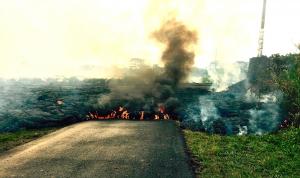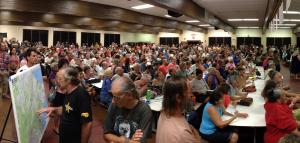(Lava flow crossed Apa‘a Road in Puna in October 2014 and threatened power lines. Credit: USGS.)
By Staff Reports
(Oahu)– The University of Hawaiʻi at Mānoa will receive $1.2 million in funding from the National Science Foundation as part of a six-university collaboration with the Volcano Hazards Program of the U.S. Geological Survey (USGS), studying volcanic crises at Kīlauea, Hawai‘i, and Long Valley, California. The study will be made by seven institutions: USGS, UHM, University of California – Berkeley, University of Washington, and Duke and Marquette Universities, and is led by University at Buffalo.
“The goal is to improve our relationship with ‘restless,’ potentially dangerous, active volcanoes in the United States,” said Kīlauea project lead Bruce Houghton, the Gordon A. Macdonald Professor of Volcanology at UHM and Hawai‘i State Volcanologist. “Moderate to large volcanic eruptions in this country are infrequent but long-lasting and high-consequence events with multiple hazards.”
Houghton leads the Kīlauea project along with geologist Chris Gregg and Professor Karl Kim at UHM’s National Disaster Preparedness Training Center.
Said Houghton, “Volcanic crises contain a swarm of volcanological, engineering, human, planning and economic problems, often with very high levels of uncertainty in all types of data. The uncertainties in how the volcano, the community and decision-making institutions will behave can turn events into crises and sometimes disasters.”
As a consequence, the costs of volcanic crises are often out of proportion to the magnitude of the parent eruptions.
“This exciting, multi-disciplinary program will provide important new insights into how hazardous volcanic processes and complex volcanic systems behave,” said Christina Neal, Scientist-in-Charge at the USGS Hawaiian Volcano Observatory (HVO). “Moreover, the integration of this scientific understanding with results from novel social science investigations will improve the ways we communicate information to those at risk.”
A key component of this project is recruitment of graduate students and young researchers into interdisciplinary hazard research to train the next generation of volcanologists and hazard researchers in the United States. These individuals will split time between a home university and either the USGS HVO or the USGS California Volcano Observatory in Menlo Park, California.
This project will link closely to agencies with formal responsibility for hazard science and assessment in Hawai‘i, via multiple interactions with state and county emergency management, and the Federal Emergency Management Agency. The study will also strengthen the already robust research partnership between the USGS HVO and the UHM Department of Geology and Geophysics.


